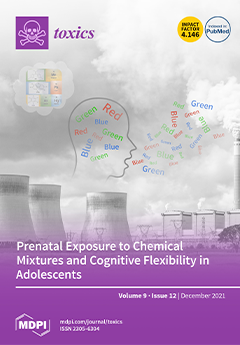Pesticides such as endosulfan, heptachlor and dieldrin persist in aquatic environments as a result of their resistance to biodegradation. However, there is no adequate information about the toxicity of endosulfan, heptachlor and dieldrin to the aquatic organism, African catfish (
Clarias gariepinus)—a
[...] Read more.
Pesticides such as endosulfan, heptachlor and dieldrin persist in aquatic environments as a result of their resistance to biodegradation. However, there is no adequate information about the toxicity of endosulfan, heptachlor and dieldrin to the aquatic organism, African catfish (
Clarias gariepinus)—a high valued widely distributed commercially interesting species. The current experiment was performed with the aim to determine the median lethal concentration (LC
50) of endosulfan, heptachlor and dieldrin to African catfish (
Clarias gariepinus); their behavioral abnormalities and histopathological alterations in several vital organs. A total of 324 juvenile fish were exposed for 96 h to six concentrations of endosulfan and dieldrin at 0, 0.001, 0.002, 0.004, 0.008 and 0.016 ppm, and to heptachlor at concentrations of 0, 0.02, 0.04, 0.08, 0.16 and 0.32 ppm for dose-response tests. The study demonstrated that the species is highly susceptible to those contaminants showing a number of behavioral abnormalities and histopathological changes in gill, liver and muscle. The 96-h LC
50 value of endosulfan, dieldrin and heptachlor for the African catfish was found as 0.004 (0.001−0.01) mg/L, 0.006 mg/L and 0.056 (0.006−0.144) mg/L, respectively. Abnormal behaviors such as erratic jerky swimming, frequent surfacing movement with gulping of air, secretion of mucus on the body and gills were observed in response to the increasing exposure concentrations. Histopathological alterations of liver, gill and muscle tissues were demonstrated as vacuolization in hepatocytes, congestion of red blood cells (RBCs) in hepatic portal vein; deformed secondary lamellae and disintegrated myotomes with disintegrated epidermis, respectively. These findings are important to monitor and responsibly manage pesticide use in and around
C. gariepinus aquacultural areas.
Full article






